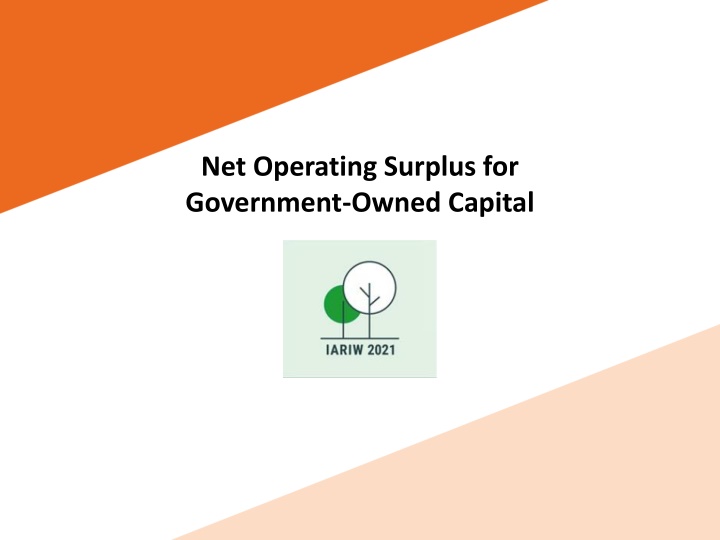
Net Operating Surplus for Government-Owned Capital Analysis
Explore the intricacies of net operating surplus for government-owned capital assets compared to business-owned assets. Delve into the challenges, implications, and calculations involved in understanding and managing such assets over time.
Download Presentation

Please find below an Image/Link to download the presentation.
The content on the website is provided AS IS for your information and personal use only. It may not be sold, licensed, or shared on other websites without obtaining consent from the author. If you encounter any issues during the download, it is possible that the publisher has removed the file from their server.
You are allowed to download the files provided on this website for personal or commercial use, subject to the condition that they are used lawfully. All files are the property of their respective owners.
The content on the website is provided AS IS for your information and personal use only. It may not be sold, licensed, or shared on other websites without obtaining consent from the author.
E N D
Presentation Transcript
Net Operating Surplus for Government-Owned Capital Poster-Paper 35
Net Operating Surplus for Government-Owned Capital Brian Sliker The views expressed in this paper are those of the author and do not necessarily represent the U.S. Bureau of Economic Analysis or the U.S. Department of Commerce.
The Problem: Business-owned capital assets have usual capital costs (net returns + capital consumption) Government-owned capital assets do not (only capital consumption, no net returns) Why? What s behind this? Net returns would involve governments in filthy lucre? Governments manage badly: net return is zero at best? Governments manage too well: best to conceal returns? Something else? SNA 6.130 They all disagree, except that own rate-of-return (r) must equal 0. 3 4/4/2025
The Real Problem: Resale-value of an asset should the expected discounted sum of its future supposed rental earnings, under any plausible optimization. Discounting involves the own rate-of-return r (= nominal r-o-r, less expected revaluation rate) If that same r is missing from the construction of future rents, the resale-value is not made whole. r=0 in the rents and the discounting works, but what does the government tell the bond markets? 4 4/4/2025
A Simple Exercise: 1 Construct user-costs for assets through time: ?: Own rate of return ? ??,?+1 ? Et o ??,?= ??,? ?? 1 + ??,? ? ??,? 0 horizon nom. interest rate Depreci ation rate Investment deflator Expected revaluation rate Multiply user-costs by capital stocks. Sum up: Result is a fully-fledged Gross Operating Surplus consisting of a depreciation component ( capital consumption ) and a non-zero Net Operating Surplus. 5 4/4/2025
A Simple Exercise: 2 U.S. federal government owns 25 high-level asset types: Defense assets Non-defense assets 6 Equipment types 1 Equipment type 3 Structures types 11 Structures types 2 Intellectual types 2 Intellectual types Conduct the exercise for all 25 types, over 1987-2019. Subnational governments (i.e., states and localities) own a greater volume of assets (chiefly roads and schools), but they are not treated here. 6 4/4/2025
A Simple Exercise: 3 Implicit investment-deflators and depreciation rates are calculable from U.S. national accounts. Zero-horizon nominal interest rates are estimable from U.S. Treasury daily yield-curve results, averaged to years. Expected investment-price revaluation rates are estimated by Kalman filter/smoother. N.B.: Subnational governments (i.e., states and localities) own a greater volume of assets (chiefly roads and schools), but they are not treated here. 7 4/4/2025
0-Horizon Nominal Interest Rates Always just below overnight Federal Funds rate 1987-89: extrapolated from Liu-Wu (2021) 1990- : extrapolated from published US Treasury yield curve 8 4/4/2025
Selected Kalman Filter Results Equipment and intellectual assets generally fit better than structures, but even poor fits are smoother than perfect foresight ex post observations. 9 4/4/2025
Aggregate Federal Exercise Results Asset-type revaluations cancel out in the federal aggregate. Federal N.O.S. positive 1987-2001, negative 2009-2019. A business wouldn t operate this way, but government is not a business, even though it optimizes in pursuit of its own goals. 10 4/4/2025
Thank you! Brian Sliker brian.sliker@bea.gov 11 4/4/2025
